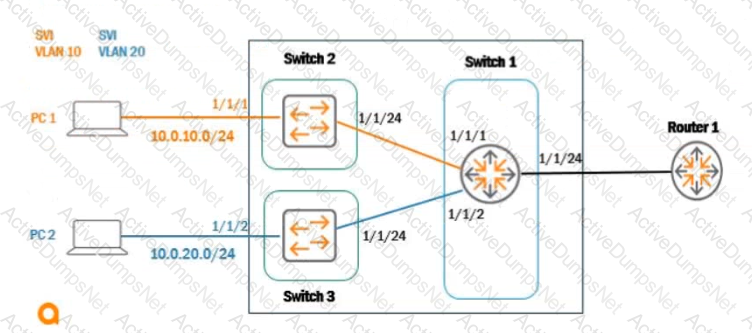HP HPE6-A85 Aruba Certified Campus Access Associate Exam Exam Practice Test
Aruba Certified Campus Access Associate Exam Questions and Answers
Which statement about manual switch provisioning with Aruba Central is correct?
A network technician is testing a new SSID for a branch office. They are able to connect, get an IP address, and resolve DNS names. However, they are not able to browse the internet.
On the existing SSID at the branch, connectivity to the internet works as expected on the same VLAN as the new SSID. The wireless client should have received a new role to allow internet access.
What should the network technician verify to ensure both SSIDs function in a similar way?
What are two advantages of a UXl? (Select two.)
What does WPA3-Personal use as the source to generate a different Pairwise Master Key (PMK) each time a station connects to the wireless network?
Match the Open Systems Interconnection (OSI) layer with its function.

A network technician has successfully connected to the employee SSID via 802 1X Which RADIUS message should you look for to ensure a successful connection?
When using the OSPF dynamic routing protocol on an Aruba CX switch, what must match on the neighboring devices to exchange routes?
Describe the purpose of the administrative distance

Based on the given topology, what is the requirement on an Aruba switch to enable LLDP messages to be received by Switch 1 port 1/1/24. when Router 1 is enabled with LLDP?
A network technician at a branch office is connecting VolP phones to a newly configured AOS-CX switch. Users are complaining that voice quality is not as good as at the corporate office. Further investigation
shows the local-priority value at the branch office is 1 while at the corporate office is 5.
What describes the issue regarding the default QoS behavior on the AOS-CX switch?
Which authentication does Aruba's Captive Portal use?
You need to troubleshoot an Aruba CX 6300F switch that fails to boot correctly. Select the option that allows you to access the switch and see the boot options available for OS images and ServiceOS.
Match the most cost-effective option for cabling each requirement. (All lengths indicate total cable length including patch cable(s), service loops, etc. where used.)

When using Aruba Central what can identify recommended steps to resolve network health issues and allows you to share detailed information with support personnel?
A network administrator with existing IAP-315 access points is interested in Aruba Central and needs to know which license is required for specific features Please match the required license per feature (Matches may be used more than once.)

What happens when the signal from an AP weakens by being absorbed as it moves through an object?
You have been asked to troubleshoot failed connectivity between a local subnet in the HQ Office and a remote subnet in the Branch Office. PC1 is unable to ping PC2.
Use the provided topology and show command output to identify the reason for the failure:

What change does a client make when it roams from one access point to another in a WLAN?
A network technician is deploying "headless" devices in the warehouse at the HQ location. So far, an SSID with 802.1X has been configured. However, these new devices lack 802.1X support.
Which option would provide enhanced security for these devices?
What describes Clearpass OnGuard? (Select two.)
A network technician is verifying that a customer successfully connected to the guest network after completing the captive portal. The network technician looks at the access tracker in ClearPass.
Which role should be seen when looking at the OUTPUT tab for the customer's session?
A client connects to an Aruba AP in tunnel mode and is assigned to a VLAN based on the client's MAC address.
Which client VLAN assignment was configured?
When using the network check page in Central, what kind of tests can you run on switches? (Select two.)
What is the ideal Aruba access switch for a cost-effective connection to 200-380 clients, printers and APs per distribution rack?
Two independent ArubaOS-CX 6300 switches with Spanning Tree (STP) settings are interconnected with two cables between ports 1/1/1 and 1/1/2 All four ports have "no shutdown" and "no routing" commands
How will STP forward or discard traffic on these ports?
Which flew in a Layer 3 IPv4 packet header is used to mitigate Layer 3 route loops?
What is used by network devices to send error and operational information related to IP communications?
What is the recommended UXI monitoring solution in large logistic facilities?
A hospital uses a lot of mobile equipment for the diagnosis and documentation of patient data What Is the ideal access switch for this large hospital with distribution racks of over 400 ports in a single VSF stack?
A hacker has altered a user's 3-Way Handshake in order to gain access to their session.
Which security mechanism would intelligently deny this traffic?



